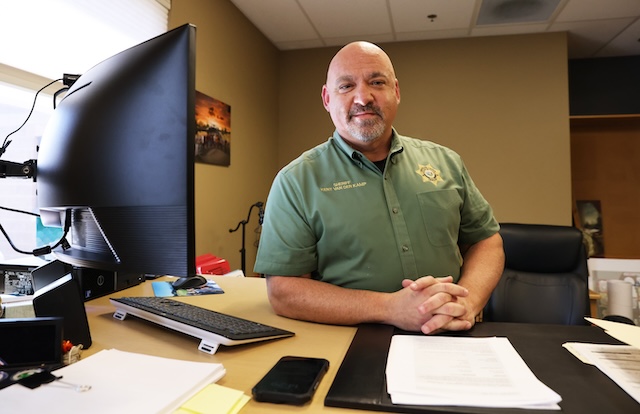Payday lending: Helpful service or pitfall of debt?
Published 5:00 am Thursday, August 5, 2010

- Yvonne Sands, standing in her Dallas home, has been using payday loans in order to keep afloat, and the debt is spinning out of control.
DALLAS — On July 2, a 74-year-old Dallas widow named Yvonne Sands received her monthly Social Security check of $1,360. Soon after 7:30 a.m., she withdrew money from the bank and drove off to renew four payday loans with annual percentage rates of about 250 percent to more than 300 percent.
Sands can’t afford to pay back the loans all at once, and they come due every month. So each month, she takes out new loans to pay for the old ones, shelling out nearly $400 in fees in the process.
Over the last year, Sands has paid more than $4,200 in fees on those four loans — far more than the $1,850 she received in principal. And that’s not counting fees on two other loans she paid off earlier this year, one of which carried an annual rate of about 660 percent.
“I’m just trying to dig myself out of this hole I’m in,” Sands said.
Borrow with ease
For better or worse, millions of Americans like Sands borrow billions of dollars a year from payday lenders. Catering to low- and middle-income customers, payday lenders provide quick cash to just about anyone with a checking account and a steady income.
Payday lenders say they’re making risky unsecured loans to willing customers scorned by other financial companies. Critics say payday loans trap customers in a downward debt spiral, siphoning off their income as they struggle to repay.
Payday lending has ballooned over the past decade, and Texas is an industry mecca, with payday lenders in the state providing about $3 billion in credit a year, according to industry estimates.
How they work
Here’s how they work: A customer goes to a payday lender wanting a $350 loan, the average amount in Texas.
The customer writes out a check for $350 plus a lending fee, typically postdated to the next payday. Fees typically range from $15 to $22 per $100 borrowed, according to the Consumer Service Alliance of Texas, an industry group.
The loan is typically due on the customer’s next payday. If the customer doesn’t show up, the lender cashes the check.
Alternatively, Texas clients can pay the fee and take out a new $350 loan to pay for the first — but that means paying another fee when the second loan comes due. They can also pay the fee plus whatever else they can afford, and refinance the balance.
In 2006, Congress passed a law capping interest rates on payday loans to military personnel, and many states restrict them. In Texas, the state constitution considers interest rates above 10 percent to be usurious except when specifically allowed by the legislature.
But under a legal loophole, payday lenders charge fees, not interest. Regulation of payday loans is lax, critics say.
“There is an absolute complete lack of oversight of the payday lending industry in the state of Texas,” said state Sen. Wendy Davis, a Tarrant County Democrat.
While Sands says she rues the day she walked into a payday loan outlet, other customers say they appreciate payday loans for their speed, convenience and accessibility. Low credit scores are generally no obstacle.
Abel Martinez, 24, took out a $100 payday loan after his hours were cut back at Walmart, where he loads trucks. He said he prefers the loans to his credit card because he’s afraid of overspending on the card.
Shirley Proctor, 48, who cleans patients’ hospital rooms, took out a $600 payday loan in May after her car broke down. She aims to pay the loan off “hopefully soon.”
Jackie Williams, a medical records processor in her early 40s, recently borrowed $400 to fix her car. “It has been helpful,” she said, adding that she expects to pay the loan back by Aug. 1.
All three recently paid loan fees at a southern Dallas branch of Advance America Cash Advance Centers Inc., the nation’s largest payday lender.
Inviting environment
The cheery storefront has clean white walls, spotless green carpeting and ads for “Loans up to $1,000 restamos de hasta $1,000” on its exterior glass. The company and the Consumer Service Alliance of Texas recently invited a reporter and a photographer for a visit.
Inside, posters on the walls advertise a range of financial services, from debit cards to electronic money transfers to utility payments. A store employee explains loan costs to customers.
The Consumer Service Alliance says its members have 2,400 stores “in every legislative district in Texas.” Nationally, there are nearly 21,000 payday loan stores, according to David Burtzlaff, a financial analyst at Stephens Inc. in Dallas.
That’s about as many U.S. locations as McDonald’s and Burger King have combined.
North Texas is an industry epicenter, home to small-dollar corporate giants such as Fort Worth-based Cash America International Inc. and Irving, Texas-based Ace Cash Express. The Cash Store belongs to Irving-based Cottonwood Financial.
Since 2005, payday lenders in Texas have not been considered lenders at all, but rather “credit service organizations.”
Legally speaking, they charge a fee for connecting borrowers with third-party lenders such as DSI Lending Resources Inc. and NCP Finance LP.
Thus, credit service organization fees escape the state’s restrictions on high-interest lending.
Other options to get quick cash
Advances from employers: Some employers grant paycheck advances. Because this is a true advance rather than a loan, there is no interest and the advance is therefore cheaper than a payday loan.
Emergency assistance programs: Many faith-based groups and community organizations provide emergency assistance, either directly or through social services programs.
Credit union loans: Many credit unions offer small short-term loans to their members. Many also offer low annual percentage rate loans (prime to 18 percent) with quick approval on an emergency basis. Unlike payday loans, these give borrowers a real chance to repay, with longer payback periods and installment payments.
Cash advances on credit cards: A $300 cash advance on the average credit card, repaid in one month, would cost a $13.99 finance charge and have an annual interest rate of almost 57 percent. By comparison, a payday loan costing $17.50 per $100 for the same $300 would cost $105 if renewed one time, or an annual interest rate of 426 percent.
Military loans: Several companies offer loans of $500 to $10,000 to active-duty and retired military personnel. These loans cost far less than payday loans because they have a much lower APR, 33 percent to 34.99 percent.
Small consumer loans: Small consumer-finance companies offer small short-term loans that cost up to 60 percent APR but usually are in the range of 25 percent to 36 percent APR. If you borrowed $500 at 36 percent APR and repaid in monthly installments over four months, you would have paid $38.04 in interest. If you renewed a $500 payday loan every two weeks for the same four months, you would have paid $700 in fees if the fee was $17.50 per $100.
Source: The Center for Responsible Lending






